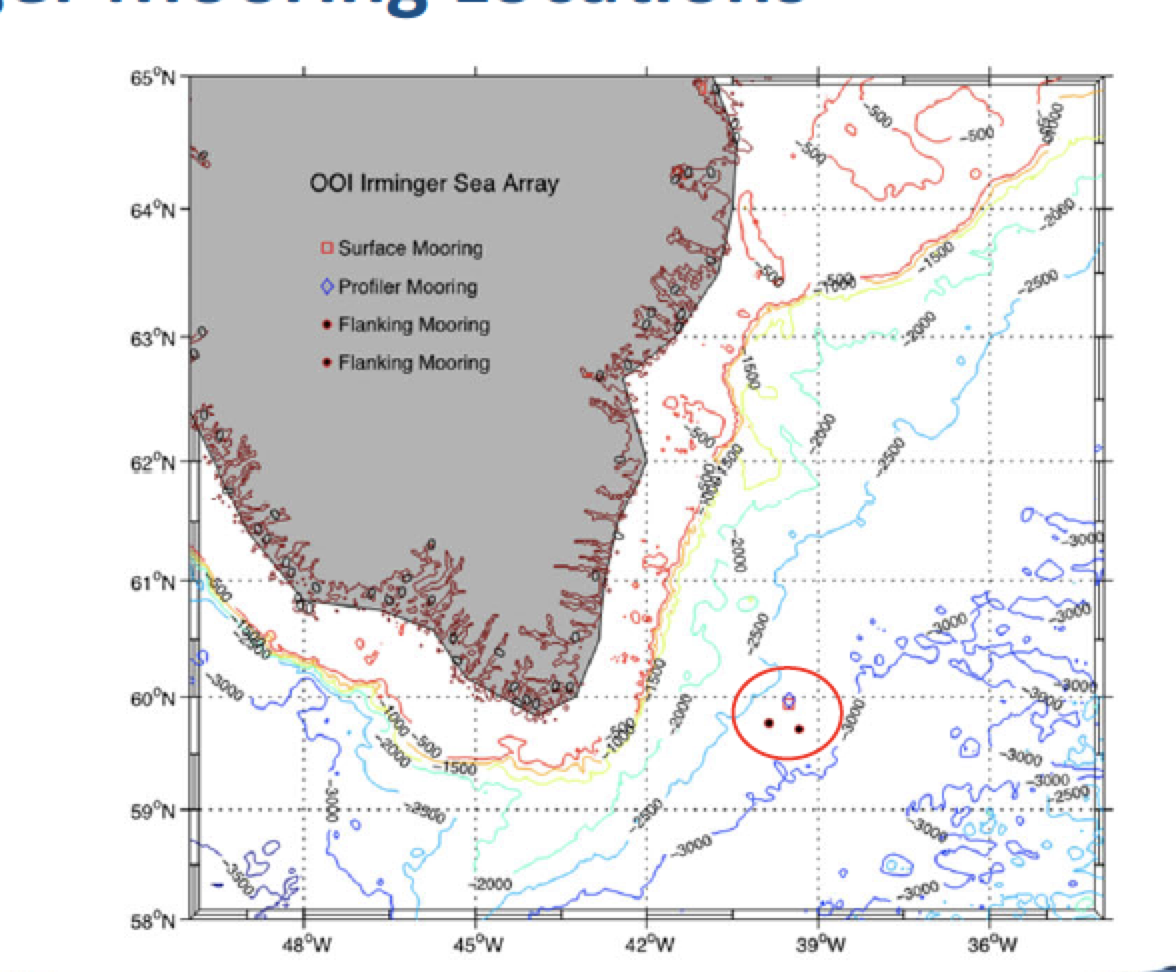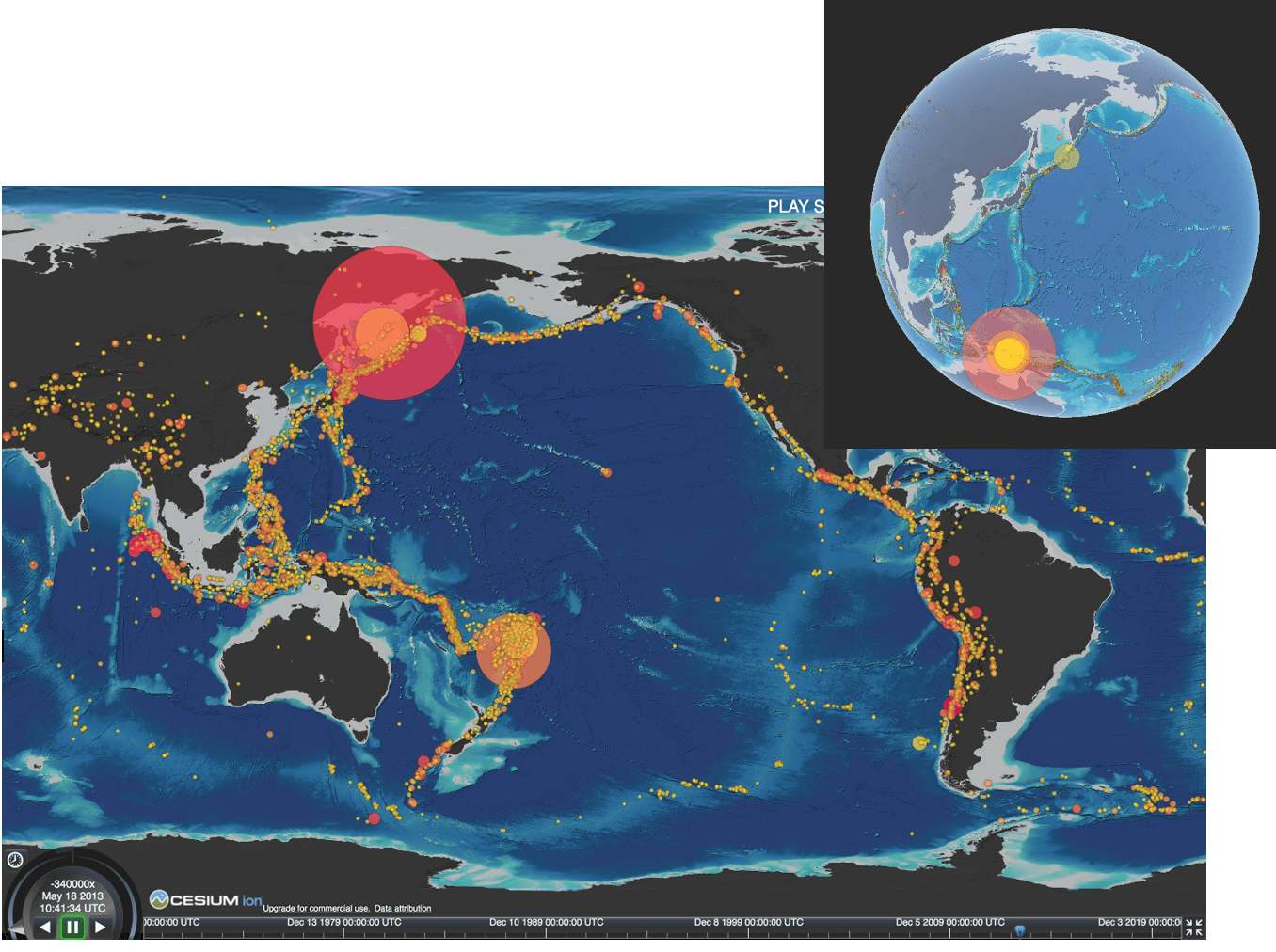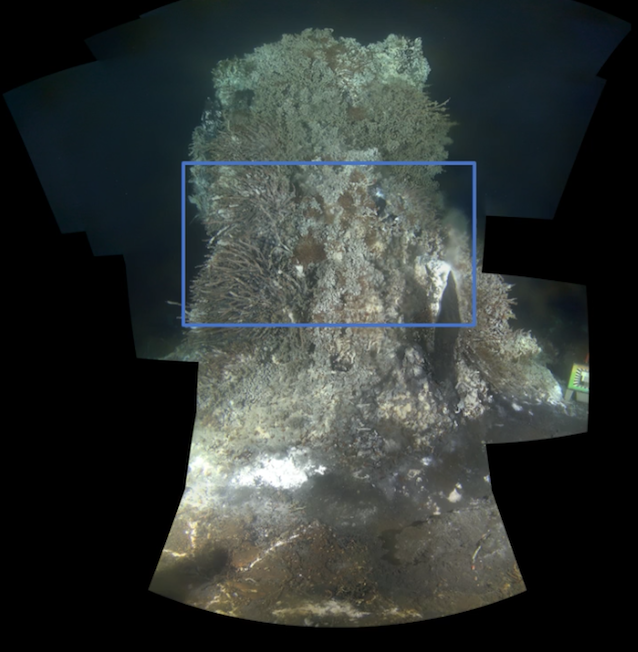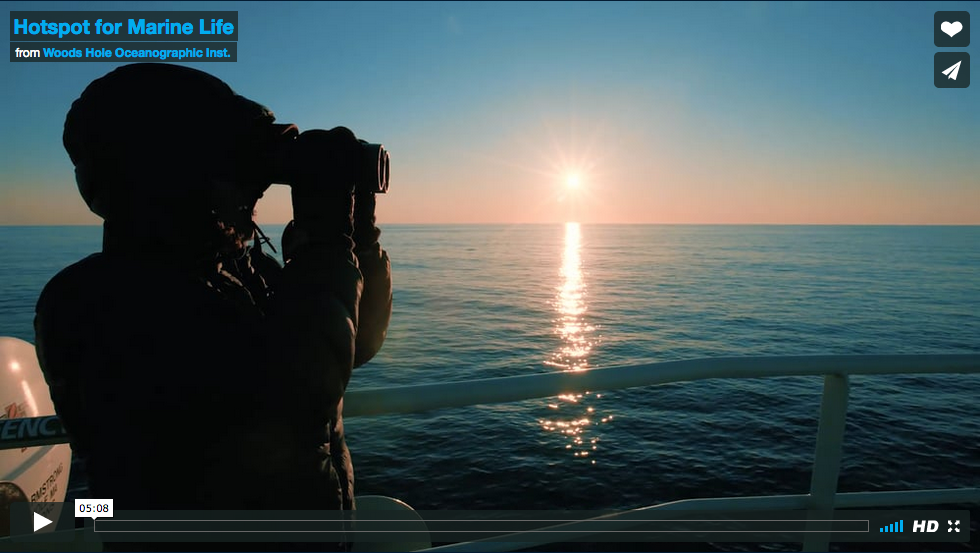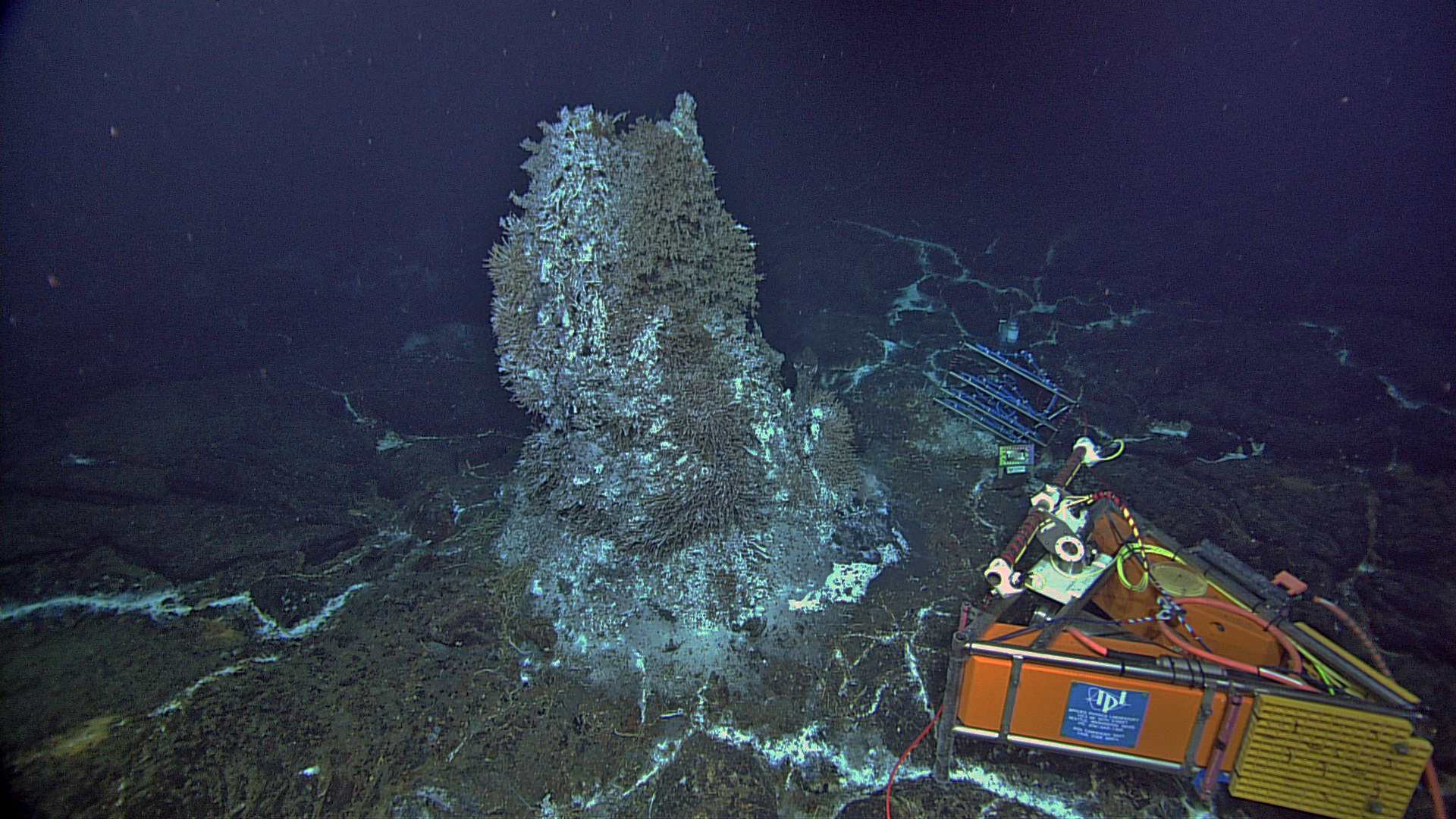Irminger Sea Array Overcomes Challenging Conditions to Provide Climate Insights
Deployed 140 miles east of the southern tip of Greenland and three miles south of the Arctic Circle, the Irminger Sea surface mooring floats on a cold empty sea named for a Danish naval admiral few people have heard of, in a location that few people could point to on a North Atlantic chart. The Irminger Sea is delineated less by coastlines or geographic basins and more by what is taking place within the deep ocean here, processes only visible with the aid of deep-sea instruments. To oceanographers and climate scientists the region is a confluence of ocean currents where heat carried from the topics gets extracted and cold water sinks into abyss like few other places worldwide and with climate-changing impacts.
Like most high-latitude oceans, storms are frequent and strong. Some storms migrate northeast from the mid-latitudes. Other storms are born here and then mature to impressively violent conditions influenced by the distant high mountains and massive Greenland icecap. Gale-force winds and steep-faced ocean waves spread east over a wide cone from the tip of Cape Farewell. The ice pack around Greenland ejects icebergs, some washing far out to sea where they threaten vessels. Cold air and sea spray build layers of heavy ice on exposed surfaces and instrument sensors. Other oceans can be found with higher waves, some have colder weather, but in few places do storms intensify so quickly, occur as often, and happen in a place so vital to planetary climate. Right where the storm forces are the strongest is also the perfect place for a tower packed with weather instruments.
The Irminger Sea mooring is designed to collect data in this stormy world where meteorological and ocean measurements, especially at the surface, are rare and hard to sustain. The mooring is recovered and a new one put in its place once a year, typically during the short summer month of July when weather conditions are calmest. At more than 4 meters high, the surface mooring tower is heavily instrumented with meteorological sensors and communication antennas, and the surface float is filled with data loggers and redundant computing elements and controllers that collect, store, and transmit data to shore. In total about four tons of floating equipment is anchored to the bottom by a 1.5-mile cable studded with dozens of instruments sampling the deep interior of this sea. To power everything, the buoy float is packed with rechargeable batteries, fueled by solar panels and wind turbines on the buoy tower. Strong winds are usually welcome because they rapidly re-charge the battery packs. Sometimes, however, these can be too much of a good thing.
[media-caption path="/wp-content/uploads/2021/12/Irminger-storm-waves.png" link="#"]Storm waves captured by the Irminger Sea tower camera #5 on 2019-03-19 at 09:01:00 UTC during a typical bad weather day. Observations made by the WAVSS instrument (from 09:00 to 09:20 UTC) report significant wave heights around 5 m (16 ft) and maximum heights of 21 m (69 ft). Records from a second accelerometer (MOPAK) report a wave ~5 m high passing at 09:01 UTC, possibly the same one in this photo. About half-a minute later, at 09:01:30 UTC, the MOPAK recorded a wave >20 m (no image).[/media-caption]
A recent storm during October 18-19, 2021, was one such time. The mooring was battered by wind speeds exceeding 35 knots (gale force) for almost 24 hours, with some topping out above 50 knots. Heavy storm seas built up and stacked upon themselves for hours. At the storm’s peak, about one third of the highest waves were above 15 m (49 ft). Picture heaving an 8000 lb. surface mooring 80 ft up and down on a tilt-a-whirl ride that never stops. Waves this high can bring tons of water crashing down. Towering waves were recorded, some reaching up to 20-25 m (66-82 ft), so high they approached the limits of our instruments.
The Irminger Sea continues to test our ability to “weather harden” instruments in stormy parts of the world. From November to March, daylight is fleeting, the sun hovers near the horizon and solar panels trickle out only a few milliamps. For the next few months, many of the instruments in the ocean interior and on the tower will continue to sample, each instrument powered by its own small battery. The Irminger surface mooring will communicate once each day, a tiny burst of data with vital signs, until spring returns and the sun revives the cold battery packs.
[media-caption path="/wp-content/uploads/2021/12/Ice-near-mooring-.png" link="#"]Ice near the Irminger Sea mooring 2019-04-02. Credit: @WHOI, Peter Brickley.[/media-caption]
The 2021 storm demonstrated, yet again, the challenges of working in the Irminger Sea. Yet, it also demonstrated the remarkable robustness of the OOI moorings in such extreme conditions. Ocean and meteorological measurements gathered by the Irminger Sea mooring during such storm events are extremely valuable for understanding oceanography and climate processes. Equally important is the invaluable experience gained that will drive continued improvement in the accuracy and durability of instruments deployed under such extreme conditions, with consequent increases in knowledge.
Written by Peter J. Brickley, PhD, Senior Engineer, AOPE Dept., Woods Hole Oceanographic Institution and OOI’s Coastal and Global Scale Nodes Observatory Operations Lead
Read More
RCA Recording Swarm of Earthquakes in Real Time
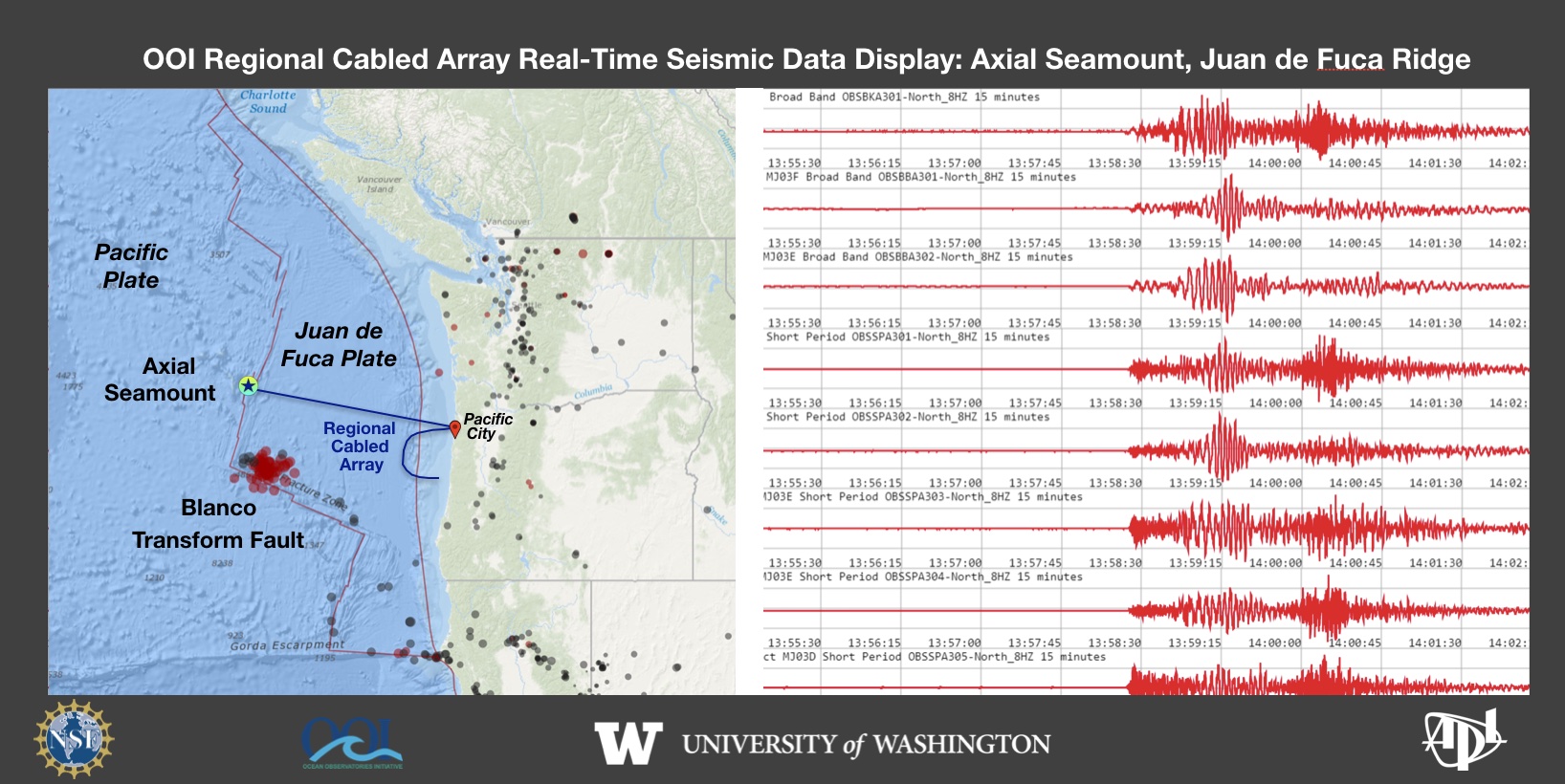 On December 7, 2021 a swarm of earthquakes began on the Blanco Transform Fault, a major plate boundary at the southern end of the Juan de Fuca Plate. The ongoing seismic swarm is being tracked live by the National Science Foundation’s underwater observatory, the Regional Cabled Array (RCA). The RCA is a component of NSF’s Ocean Observatories Initiative and is operated and maintained by the University of Washington. It includes ~900 km of high power and high bandwidth submarine fiber optic cables that stretch from Pacific City, OR out to the most active volcano off the coast “Axial Seamount” that erupted in 1998, 2011 and again in 2015. A second cable heads south along the Cascadia Subduction Zone and turns east along the Cascadia Margin off Newport, OR. Over 150 instruments on the seafloor and on instrumented moorings provide real-time data flow to shore at the speed of light. A suite of seismometers at the summit of Axial Seamount lit up on December 7, 2021 as the seismic swarm began along the Blanco. This live feed was developed by the UW Applied Physics Laboratory.
On December 7, 2021 a swarm of earthquakes began on the Blanco Transform Fault, a major plate boundary at the southern end of the Juan de Fuca Plate. The ongoing seismic swarm is being tracked live by the National Science Foundation’s underwater observatory, the Regional Cabled Array (RCA). The RCA is a component of NSF’s Ocean Observatories Initiative and is operated and maintained by the University of Washington. It includes ~900 km of high power and high bandwidth submarine fiber optic cables that stretch from Pacific City, OR out to the most active volcano off the coast “Axial Seamount” that erupted in 1998, 2011 and again in 2015. A second cable heads south along the Cascadia Subduction Zone and turns east along the Cascadia Margin off Newport, OR. Over 150 instruments on the seafloor and on instrumented moorings provide real-time data flow to shore at the speed of light. A suite of seismometers at the summit of Axial Seamount lit up on December 7, 2021 as the seismic swarm began along the Blanco. This live feed was developed by the UW Applied Physics Laboratory.
Read More
Seismic Hazards Around the Globe: A Visualization Tool to Bring RCA Data into the Classroom
As part of the continuing University of Washington engagement effort, and in preparation for the new National Science Foundation K12 education award focused on bringing OOI data into the classroom, Kelley collaborated with the Center for Environmental Visualization within the School of Oceanography to generate an earthquake exploration tool focused on seismic events within the global oceans from 1970 to present. We anticipate that one of the curriculum modules developed for the K12 program will be focused on geohazards, with an emphasis on the Cascadia Subduction Zone within the context of the “ring of fire.” A video of this animation is hosted on interactive oceans and a direct link to the developmental site is provided above. The animation will be used in a Queens College physical geology class this next year that has 150 students (Dr. Dax Soule). This effort is also in preparation for completing a similar visualization focused on Axial Seamount and Regional Cabled Array seismic data.
The data sets used for this effort include a map centered on the Pacific Ocean that shows the distribution of earthquakes of magnitude ≥6 in the U.S. Geological Survey catalog from 1970 through 2021. The topographic dataset is licensed under Creative Commons CC BY-4.0. The data were formatted to match the JSON format recommended for use of global visualization using the ‘Cesium’ interactive virtual earth viewer promoted within its 3D geospatial visualization for the web toolset. The Cesium JavaScript API was utilized to implement algorithms for procedural color determination based on magnitude and hypocenter point radius animation based on the date-time of the earthquake event. The resultant animation is highly interactive, allowing the user to choose a 3D global view or a flat view, and viewing speeds of 1-8 times. In addition, the field of view can be changed to move to a specific area of interest and includes zoom capabilities. A sliding time bar allows the user to focus in on particular items of interest.
Read More
New Computer Vision Routine Developed for CAMHD Time-Lapse Video
A new computer vision routine, developed by Aaron Marburg at UW-APL and aided by Tim Crone at LDEO and Friedrich Knuth at Rutgers, is now able to correctly identify and tag scenes of scientific interest in the CAMHD video stream. These scenes were previously being manually identified by students at Rutgers University, a process which has been greatly accelerated by the team’s work. With this enhanced metadata record, a brand new set of time lapse videos has been created, displaying a frame captured every three hours from November, 2015 to July, 2016. There are 9 scenes of scientific interest, which are recorded at two or three zoom levels, depending on the camera routine. The naming convention for the videos is deployment_(dx) position_(px) zoom-level_(zx). For more information on the different scene tags, see the regions description on GitHub.
Position: 0
[threecol_one]Zoom Level: 0
[/threecol_one]
[threecol_one]
Zoom Level: 1
[/threecol_one]
[threecol_one_last]
Zoom Level: 2
[/threecol_one_last]
Position: 1
[threecol_one]
Zoom Level: 0
[/threecol_one]
[threecol_one_last]
Zoom Level: 1
[/threecol_one_last]
Position: 2
[threecol_one]
Zoom Level: 0
[/threecol_one]
[threecol_one_last]
Zoom Level: 1
[/threecol_one_last]
Position: 3
[threecol_one]
Zoom Level: 0
[/threecol_one]
[threecol_one]
Zoom Level: 1
[/threecol_one]
[threecol_one_last]
Zoom Level: 2
[/threecol_one_last]
Position: 4
[threecol_one]
Zoom Level: 0
[/threecol_one]
[threecol_one]
Zoom Level: 1
[/threecol_one]
[threecol_one_last]
Zoom Level: 2
[/threecol_one_last]
Position: 5
[threecol_one]
Zoom Level: 0
[/threecol_one]
[threecol_one]
Zoom Level: 1
[/threecol_one]
[threecol_one_last]
Zoom Level: 2
[/threecol_one_last]
Position: 6
[threecol_one]
Zoom Level: 0
[/threecol_one]
[threecol_one]
Zoom Level: 1
[/threecol_one]
[threecol_one_last]
Zoom Level: 2
[/threecol_one_last]
Position: 7
[threecol_one]
Zoom Level: 0
[/threecol_one]
[threecol_one_last]
Zoom Level: 1
[/threecol_one_last]
Position: 8
[threecol_one]
Zoom Level: 0
[/threecol_one]
[threecol_one_last]
Zoom Level: 1
[/threecol_one_last]
Resources
Raw Data Archive – Access to raw video data files in .mp4 and .mov format
Live Video Feed – Live video from Axial Seamount, every 3 hours for 15 minutes
CamHDAnalysis – Computer vision routine used to create metadata and time lapse videos
CamHD Compute Engine – Open access processing platform to use and develop CAMHD processing code
Download Time-Lapse Videos – Shared drive that permits download of the time-lapse videos displayed above
References
Crone, T.J., Marburg A., Knuth F. A, Using the OOI Cabled Array HD Camera to Explore Geophysical and Oceanographic Problems at Axial Seamount, presented at the 2016 Fall Meeting, AGU, San Francisco, CA
Knuth, F. A., Marburg, A., Crone, T. J. (2017) Deriving Quantitative Metrics from OOI High-Definition Video Data for the Purpose of Automated QA/QC, Oceans 2017 MTS/IEEE, Anchorage, AK, September 18-21
Knuth, F.A., Marburg, A., Belabassi L., Garzio, L., Smith, M., Vardaro, M. (2016) Automated QA/QC and Time Series Analysis on OOI High-Definition Video Data. Oceans 2016 MTS/IEEE Proceedings.
Marburg, A., Knuth, F. A., Crone, T. J. (2017) Cloud-Accelerated Analysis of Subsea High-Definition Camera Data, Oceans 2017 MTS/IEEE, Anchorage, AK, September 18-21
Funding
National Science Foundation, Cloud-Capable Tools for MG&G- Related Image Analysis of OOI HD Camera Video, Award #1700923
For additional information please contact: help@oceanobservatories.org
Read MoreVIDEO: Pioneer Observatory Investigates the Continental Shelfbreak
Axial Seamount Hydrothermal Vent Time-Lapse Videos
Undergraduate students at Rutgers University have used still frames extracted from the HD Video camera (CAMHD) to compile time-lapse videos of the hydrothermal vent, under the direction of the OOI Data Team. There are 7 biological scenes of interest, captured during the pan/zoom routine of each video. The students are helping produce metadata by time-stamping each scene of interest in every video file on the archive. The students then ran code provided by the OOI Data Team to produce time-lapse videos and watch the vent change over time at each of the scenes of interest. More videos and additional post-processing techniques will be added over time, using open-access tools.
Scene 1
Scene 3
Scene 5
Scene 6
Scene 7
Scene 8

